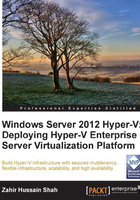
Types of virtualization
Virtualization is a broad term, and addresses a wide range of core-computing elements, but here we will mainly discuss three major types of virtualization, which are as follows:
- Server virtualization
- Network virtualization
- Storage virtualization
Server virtualization
In the first type of virtualization, we build virtual computers on a physical computer that is running virtualization software. Now let's elaborate this to better understand the concept here. This means the need of a computer that mainly comprises hard disk, processor, and RAM and other hardware components is fulfilled virtually on a physical computer with the help of the virtualization software that we call the hypervisor. By doing this we try to create as many virtual computers as is possible on a physical computer so that we can take advantage of and utilize the physical computer's installed resources and also save power, cooling, and space requirement by virtually hosting these computers.
Network virtualization
Network virtualization is when all of the separate resources of a network are combined, allowing the network administrator to share them out amongst the users of the network. This is done by splitting the resources' bandwidth into channels and allowing the administrator to assign these resources as and when required. This allows each user to access all of the network resources from his/her computer. These resources can be files and folders on the computer, printers or hard drives, and so on. This streamlined approach makes the life of the network administrator much easier, and it makes the system seem much less complicated to the human eye than it really is.
Storage virtualization
Storage virtualization has two distinct objectives, where the first objective is to separate the logical storage from the physical storage regardless of where data is stored. This allows the storage administrator to create partitions and manage data storage in a much more meaningful fashion. For an example, being a storage administrator you would like to keep fast storage disks for your ERP and Business Intelligence system, while slower disks can be allocated for file servers where speed and performance might not be needed.
Another objective of storage is to provide file-based access to data no matters where the actual data is stored. This enhances the performance and optimizes storage usage. In both ways when the storage virtualization is performed, it allows the administrator to effectively utilize the storage by taking advantage of storage automation and scalability features. Another example of storage migration is the tier-based architecture in which we divide stored data based on its classification and usage needs. So with the help of the fast cache feature, data can be moved from a slower SATA disk to a fast solid-state drive (SSD) when the I/O requirement increases from the user side.